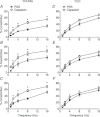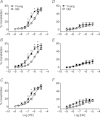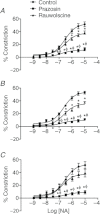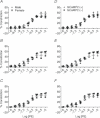Ageing alters perivascular nerve function of mouse mesenteric arteries in vivo
- PMID: 23247111
- PMCID: PMC3607869
- DOI: 10.1113/jphysiol.2012.244483
Ageing alters perivascular nerve function of mouse mesenteric arteries in vivo
Abstract
Abstract Mesenteric arteries (MAs) are studied widely in vitro but little is known of their reactivity in vivo. Transgenic animals have enabled Ca(2+) signalling to be studied in isolated MAs but the reactivity of these vessels in vivo is undefined. We tested the hypothesis that ageing alters MA reactivity to perivascular nerve stimulation (PNS) and adrenoreceptor (AR) activation during blood flow control. First- (1A), second- (2A) and third-order (3A) MAs of pentobarbital-anaesthetized Young (3-6 months) and Old (24-26 months) male and female Cx40(BAC)-GCaMP2 transgenic mice (C57BL/6 background; positive or negative for the GCaMP2 transgene) were studied with intravital microscopy. A segment of jejunum was exteriorized and an MA network was superfused with physiological salt solution (pH 7.4, 37°C). Resting tone was 10% in MAs of Young and Old mice; diameters were ∼5% (1A), 20% (2A) and 40% (3A) smaller (P 0.05) in Old mice. Throughout MA networks, vasoconstriction increased with PNS frequency (1-16 Hz) but was ∼20% less in Young vs. Old mice (P 0.05) and was inhibited by tetrodotoxin (1 μm). Capsaicin (10 μm; to inhibit sensory nerves) enhanced MA constriction to PNS (P 0.05) by ∼20% in Young but not Old mice. Phenylephrine (an α1AR agonist) potency was greater in Young mice (P 0.05) with similar efficacy (∼60% constriction) across ages and MA branches. Constrictions to UK14304 (an α2AR agonist) were less (∼20%; P 0.05) and were unaffected by ageing. Irrespective of sex or transgene expression, ageing consistently reduced the sensitivity of MAs to α1AR vasoconstriction while blunting the attenuation of sympathetic vasoconstriction by sensory nerves. These findings imply substantive alterations in splanchnic blood flow control with ageing.
Figures






Similar articles
-
Aging alters reactivity of microvascular resistance networks in mouse gluteus maximus muscle.Am J Physiol Heart Circ Physiol. 2014 Sep 15;307(6):H830-9. doi: 10.1152/ajpheart.00368.2014. Epub 2014 Jul 11. Am J Physiol Heart Circ Physiol. 2014. PMID: 25015968 Free PMC article.
-
Depressed perivascular sensory innervation of mouse mesenteric arteries with advanced age.J Physiol. 2016 Apr 15;594(8):2323-38. doi: 10.1113/JP270710. Epub 2015 Jun 30. J Physiol. 2016. PMID: 26010764 Free PMC article.
-
Regional heterogeneity of α-adrenoreceptor subtypes in arteriolar networks of mouse skeletal muscle.J Physiol. 2010 Nov 1;588(Pt 21):4261-74. doi: 10.1113/jphysiol.2010.194993. J Physiol. 2010. PMID: 20807785 Free PMC article.
-
Differential contributions of alpha-1 and alpha-2 adrenoceptors to vasoconstriction in mesenteric arteries and veins of normal and hypertensive mice.Vascul Pharmacol. 2007 May;46(5):373-82. doi: 10.1016/j.vph.2007.01.003. Epub 2007 Jan 27. Vascul Pharmacol. 2007. PMID: 17329171 Free PMC article.
-
Raised tone reveals purinergic-mediated responses to sympathetic nerve stimulation in the rat perfused mesenteric vascular bed.Eur J Pharmacol. 2007 Jun 1;563(1-3):180-6. doi: 10.1016/j.ejphar.2007.02.011. Epub 2007 Feb 17. Eur J Pharmacol. 2007. PMID: 17367778
Cited by
-
Microvascular mechanisms limiting skeletal muscle blood flow with advancing age.J Appl Physiol (1985). 2018 Dec 1;125(6):1851-1859. doi: 10.1152/japplphysiol.00113.2018. Epub 2018 Nov 9. J Appl Physiol (1985). 2018. PMID: 30412030 Free PMC article. Review.
-
Aging alters spontaneous and neurotransmitter-mediated Ca2+ signaling in smooth muscle cells of mouse mesenteric arteries.Microcirculation. 2020 May;27(4):e12607. doi: 10.1111/micc.12607. Epub 2020 Mar 15. Microcirculation. 2020. PMID: 31994289 Free PMC article.
-
Intravital investigation of rat mesenteric small artery tone and blood flow.J Physiol. 2017 Aug 1;595(15):5037-5053. doi: 10.1113/JP274604. Epub 2017 Jun 30. J Physiol. 2017. PMID: 28568894 Free PMC article.
-
An ex vivo method to evaluate vasoactivity induced by hemoglobin-based oxygen carriers in resistance vessels.Front Bioeng Biotechnol. 2024 Jun 28;12:1376806. doi: 10.3389/fbioe.2024.1376806. eCollection 2024. Front Bioeng Biotechnol. 2024. PMID: 39007056 Free PMC article.
-
Perivascular innervation: a multiplicity of roles in vasomotor control and myoendothelial signaling.Microcirculation. 2013 Apr;20(3):217-38. doi: 10.1111/micc.12035. Microcirculation. 2013. PMID: 23289720 Free PMC article. Review.
References
-
- Arenas IA, Xu Y, Davidge ST. Age-associated impairment in vasorelaxation to fluid shear stress in the female vasculature is improved by TNF-α antagonism. Am J Physiol Heart Circ Physiol. 2006;290:H1259–1263. - PubMed
-
- Aukes AM, Bishop N, Godfrey J, Cipolla MJ. The influence of pregnancy and gender on perivascular innervation of rat posterior cerebral arteries. Reprod Sci. 2008;15:411–419. - PubMed
-
- Azemin MZ, Kumar DK, Wong TY, Wang JJ, Mitchell P, Kawasaki R, Wu H. Age-related rarefaction in the fractal dimension of retinal vessel. Neurobiol Aging. 2012;33:194.e191–194. - PubMed
Publication types
MeSH terms
Substances
Grants and funding
LinkOut - more resources
Full Text Sources
Other Literature Sources
Medical
Research Materials
Miscellaneous

